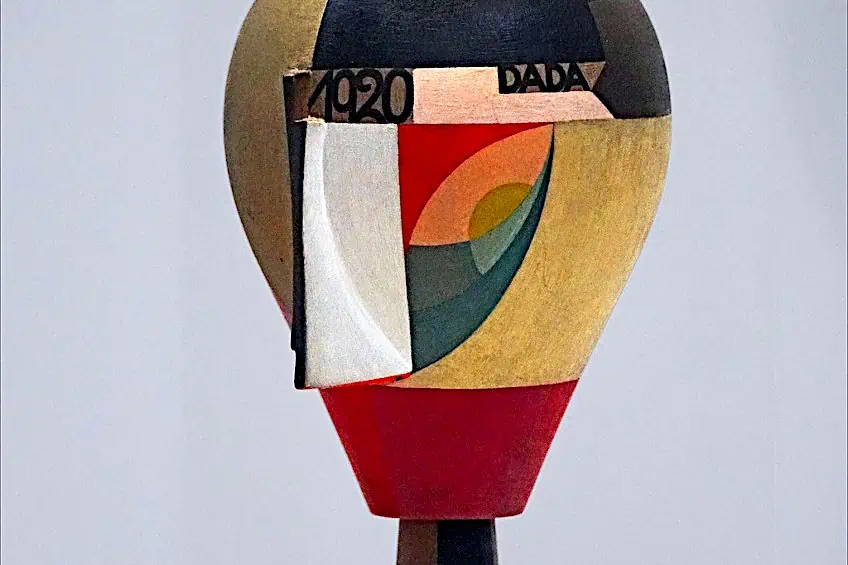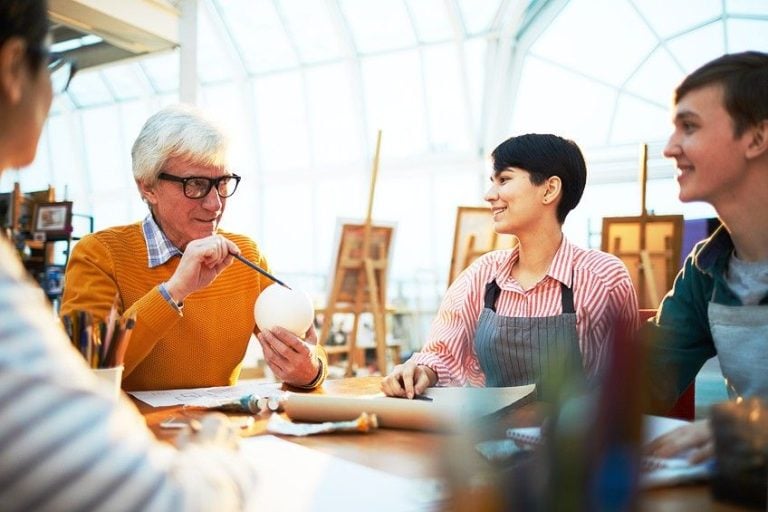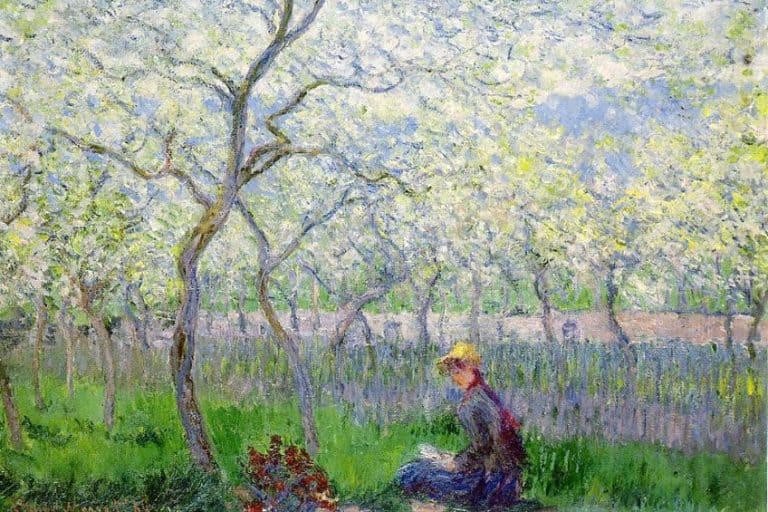Shape in Art – How Artists Use Geometric and Organic Shapes
This post may contain affiliate links. We may earn a small commission from purchases made through them, at no additional cost to you.
What is shape in art and how do famous artists effectively apply it in their works? Shape is one of the elements of art, and today, we will be examining the importance of shape in art, and exploring examples of shape in art. By gaining a better understanding of shape in art, you can apply it more effectively to your own works too!
Table of Contents
The Importance of Shape in Art
The world around us is made up of shapes, yet, how does one define shape in art? As one of the elements of art, we create shapes to depict recognizable objects, along with colors, lines, textures, values, and so on. A shape is two-dimensional, an enclosed space defined by its width and length.
By applying the other elements of art to a two-dimensional shape, one can create the illusion of three-dimensional forms.
 Man with Lantern by Tsukioka Yoshitoshi (1886); English: thesandiegomuseumofartcollection, Public domain, via Wikimedia Commons
Man with Lantern by Tsukioka Yoshitoshi (1886); English: thesandiegomuseumofartcollection, Public domain, via Wikimedia Commons
Yet, shapes in art only become truly three-dimensional forms when represented in sculpture or another medium that contains the third dimension of depth. Yet, many famous shape artists can create the illusion of three-dimensional shapes on flat canvases by using shadows and highlights.
While shape in art can be used to create representational works, they can also be used in Abstract art, where the shapes do not necessarily represent anything we would recognize in the world around us.
The Various Kinds of Shape in Art
A shape is formed when a line establishes the boundaries of an enclosed space, and the shape is the figure that is delineated by that boundary. Shape and line are two elements of art that are usually utilized together. A triangle is formed by three lines, whereas a square is formed by four lines. Shapes may be further differentiated by the use of color, value, or texture.
Shapes can also be produced without using lines, for instance, shapes produced using collages are formed by the borders of contrasting materials. Famous shape artists usually produce either geometric or organic shapes.
 Dada Head by Sophie Taeuber-Arp (1920); Jean-Pierre Dalbéra, CC BY 2.0, via Wikimedia Commons
Dada Head by Sophie Taeuber-Arp (1920); Jean-Pierre Dalbéra, CC BY 2.0, via Wikimedia Commons
Geometric Shape in Art
Geometric shapes have mathematical definitions and conventional names. They have distinct edges or borders, and painters frequently employ instruments such as compasses and protractors to render mathematically precise geometric shapes. Squares, circles, triangles, rectangles, polygons, and other shapes fall within this group. As canvases are generally rectangular in shape, a painting or photograph’s margins and bounds are implicitly defined.
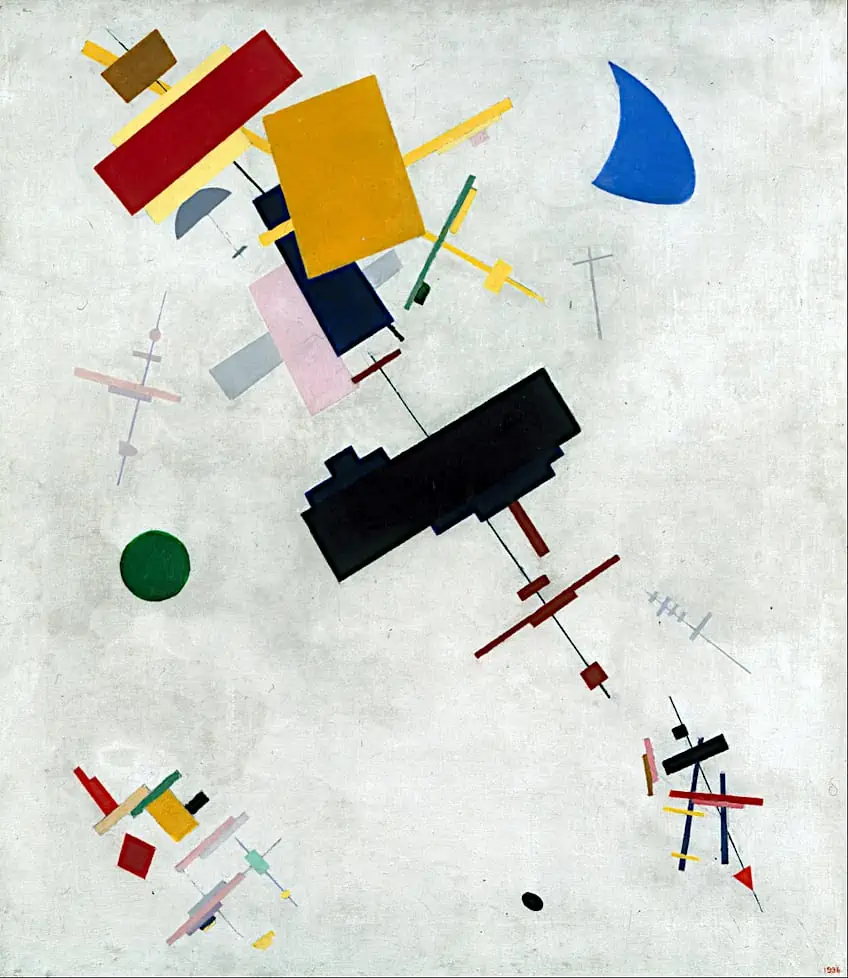 Suprematism by Kazimir Malevich (1915); Kazimir Malevich, Public domain, via Wikimedia Commons
Suprematism by Kazimir Malevich (1915); Kazimir Malevich, Public domain, via Wikimedia Commons
Artists like Reva Urban purposely break the rectangle pattern by utilizing non-rectangular canvases, adding on elements that extend out of the frames, or creating three-dimensional protrusions, dips, and swells.
In this way, Urban transcends the two-dimensional constraint of a rectangular enclosure while still referencing the shapes. Geometric types are often utilized in the design of man-made products. We can observe geometric shapes in everything from buildings to Ferris wheels.
Organic Shape in Art
Geometric forms are well-defined and symmetrical, but organic shapes are the exact opposite, often irregular and asymmetrical. You can create a freeform shape by drawing a curving line and connecting it where you started. Organic forms are the artists’ own creations: they have no labels, fixed angles, rules, or tools to facilitate their production. Organic forms may be as unstructured as a cloud or as detailed as a leaf and can often be observed in nature. Therefore, organic shapes are typically more curving and fluid, but can also be jagged or irregular, just like the objects in nature they emulate.
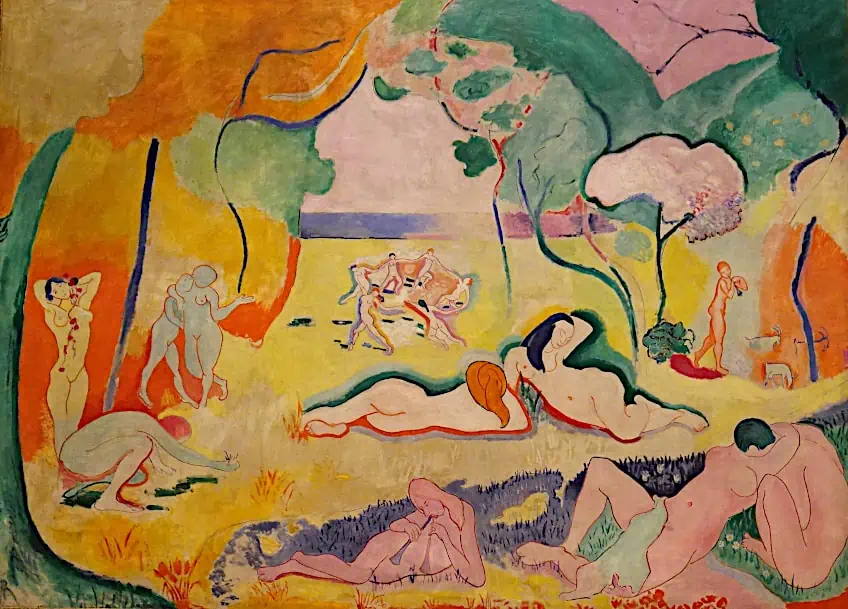 The Joy of Life by Henri Matisse (1905-1906); Regan Vercruysse from Phelps, New York, USA, CC BY 2.0, via Wikimedia Commons
The Joy of Life by Henri Matisse (1905-1906); Regan Vercruysse from Phelps, New York, USA, CC BY 2.0, via Wikimedia Commons
One of the most distinguishing features of organic shapes is that they are typically connected with movement, growth, and change. They can represent live things like animals, plants, or even the human body.
Organic shapes may convey a feeling of vibrancy, movement, and energy. Organic shapes in art can be utilized to communicate emotion or mood or to provide an impression of realism. Organic shapes can be used by artists to establish a feeling of rhythm or flow. Organic shapes can also be utilized to add depth or juxtaposition to geometric shapes or other aspects of the artwork.
Using Positive and Negative Space to Create Shape in Art
Space is yet another of the elements of art, and it creates forms in some abstract art. If you sketch a solid black coffee cup on white paper, the black represents your positive space. The negative space surrounding it as well as between the cup and the handle helps clearly articulate the cup’s fundamental shape. Artists can produce a distinct and noticeable shape that stands out by positioning a subject against a blank backdrop. This style is commonly utilized in graphic and logo design, where simple shapes express meaning or signify a brand.
As evidenced in the intriguing works of the printmaker M. C. Escher, playing with shapes can produce fascinating visual patterns while also suggesting depth and complexity.
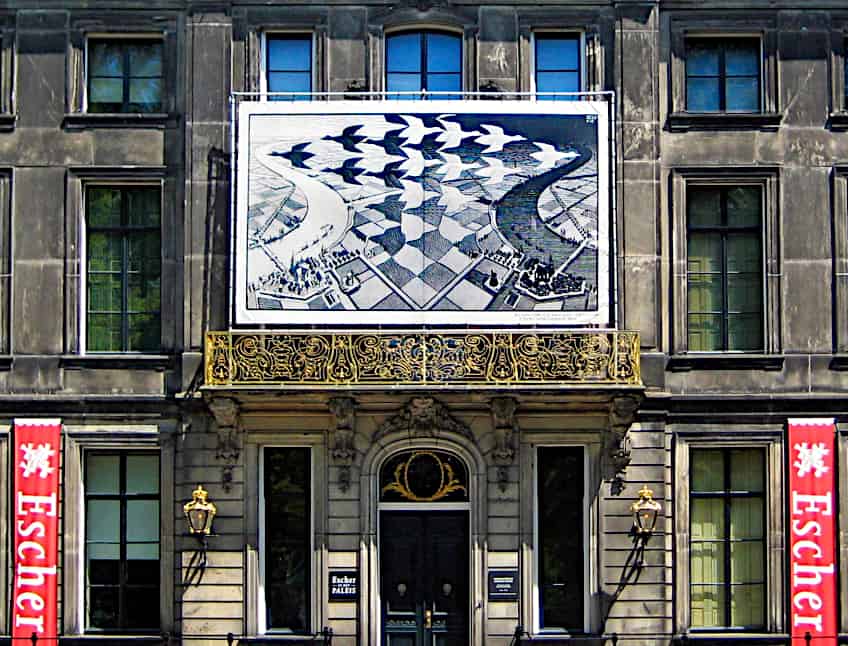 Banner on Paleis het Lange Voorhout with a print of Day and Night by M. C. Escher (1938); Escher in het Paleis, CC BY 2.0, via Wikimedia Commons
Banner on Paleis het Lange Voorhout with a print of Day and Night by M. C. Escher (1938); Escher in het Paleis, CC BY 2.0, via Wikimedia Commons
Many famous shape artists produce intricate shapes and forms that add visual appeal to an image by overlaying negative and positive space. By generating a contrast between negative and positive space, artists are able to establish a sensation of drama and tension in their artwork. This can be accomplished by the use of contrasting colors, values, and shapes.
Examples of Shape in Art
Using shape as one of the elements of art, artists have produced captivating and famous shape artworks in a myriad of unique ways. Some have created recognizable shapes while others have produced more abstract works with their non-representational shapes.
Some artists have opted to produce intricate geometric works while others prefer the freedom of organic shapes. Here are a few examples of shape in art that were all applied in unique ways.
La Orana Maria (1891) by Paul Gauguin
| Artist | Paul Gauguin (1848 – 1903) |
| Date Completed | 1891 |
| Medium | Oil on canvas |
| Dimensions (cm) | 113 x 87 |
| Location | The Metropolitan Museum of Art, New York City, United States |
This artwork was painted by Paul Gauguin on his first trip to Tahiti in 1891. It depicts an indigenous Tahitian mother and her child, both of whom are represented by utilizing the organic shapes that were characteristic of Gauguin’s aesthetic and style. He was well-known for using organic shapes in his paintings to convey a sense of the natural world and primitive sensuality. The figures of the woman and infant in this artwork are portrayed utilizing flowing, curved lines that reflect the smooth, rounded shapes of the human body.
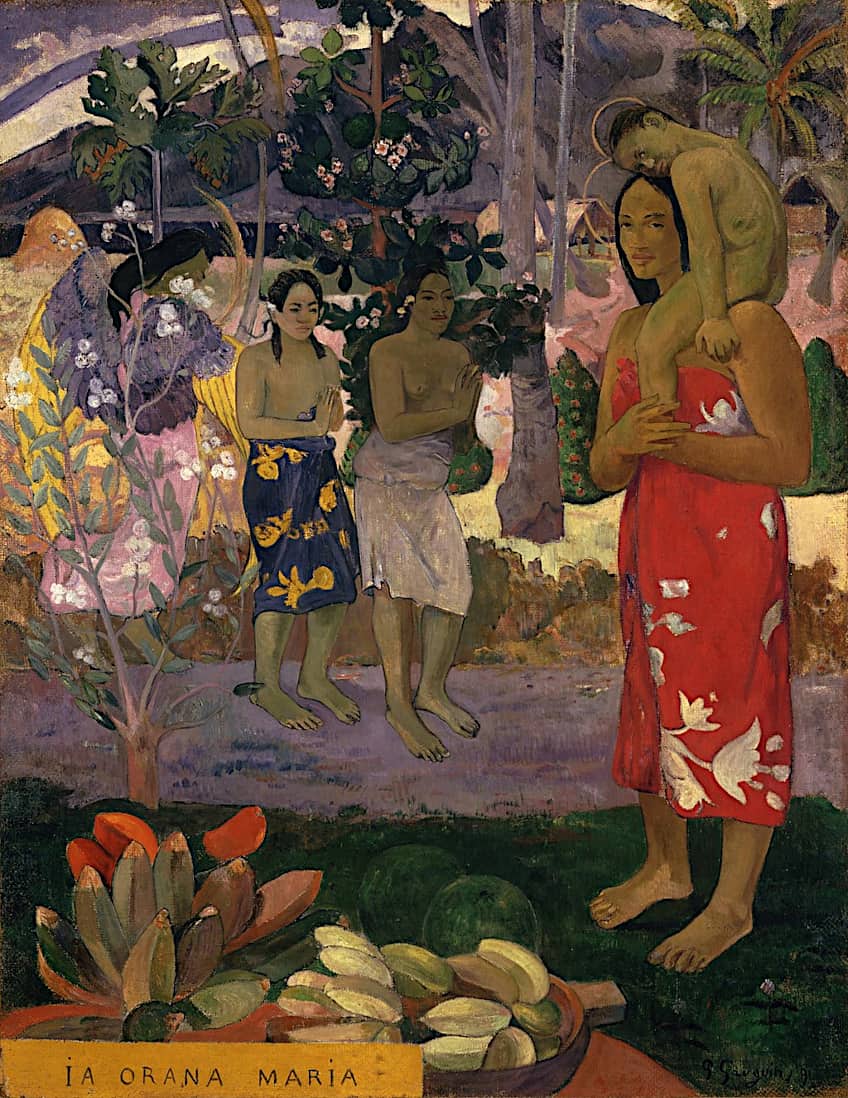 La Orana Maria by Paul Gauguin (1891); Paul Gauguin, Public domain, via Wikimedia Commons
La Orana Maria by Paul Gauguin (1891); Paul Gauguin, Public domain, via Wikimedia Commons
The organic shapes in the artwork offer the figures a sense of movement and vitality as if they are living and moving.
Gauguin depicts the rich green vegetation and colorful flowers in the surrounding area with flowing, undulating lines that evoke the natural world. The utilization of organic shapes in the environment contributes to the composition’s overall feeling of harmony, conveying a sense of connection between the characters and their environment.
Squares with Concentric Circles (1913) by Wassily Kandinsky
| Artist | Wassily Kandinsky (1866 – 1944) |
| Date Completed | 1913 |
| Medium | Mixed technique on paper |
| Dimensions (cm) | 31 x 24 |
| Location | Municipal Gallery in Lenbach House, Munich, Germany |
Wassily Kandinsky is unquestionably regarded as a master in the art world. Despite the painter’s very brief career, he already has a long list of accomplishments on his resume. Despite his fame, the artist continued to experiment, alter, and refine his craft. Therefore, in 1913, he created this famous shape artwork, a study of the interplay of various shapes and colors.
In some ways, this piece foreshadows the birth of Kandinsky’s later post-war paintings and represents a movement from the emotive and chaotic early abstractions to the rigid geometrical “bauhausstil” phase.
 Color Study: Squares with Concentric Circles by Wassily Kandinsky (1913); Wassily Kandinsky, Public domain, via Wikimedia Commons
Color Study: Squares with Concentric Circles by Wassily Kandinsky (1913); Wassily Kandinsky, Public domain, via Wikimedia Commons
Kandinsky studies the impact of various colors on the observer and the emotional reaction that these colors generate by employing the most basic shapes. All of the colors, in the artist’s opinion, have the capacity to have a twofold influence. The first is a straightforward physical effect on the audience’s sight that is comparable to pleasurable sensations, such as those derived from eating delectable cuisine.
The second impact is significantly more deep and mystical: this is what the artist referred to as “soul vibration”, internal resonance created by the contact of color straight to the innermost essence of an individual.
Red Balloon (1922) by Paul Klee
| Artist | Paul Klee (1879 – 1940) |
| Date Completed | 1922 |
| Medium | Oil on chalk-primed gauze |
| Dimensions (cm) | 31 x 31 |
| Location | Solomon R. Guggenheim Museum, New York City, United States |
While most of Klee’s work is figurative, compositional design almost always came before narrative correlation. The artist regularly turned his explorations with line and tonal value into visual tales. Red Balloon, for instance, is both a finely colored collection of drifting geometric shapes and a beautiful cityscape. The artwork is made out of geometric shapes such as rectangles, triangles, and circles. These forms are organized in an abstract manner, giving the composition a sense of depth and movement. The painting’s varied shapes appear to be in motion as if the city is alive and floating around the red balloon in the middle.
 Red Balloon by Paul Klee (1922); Paul Klee, Public domain, via Wikimedia Commons
Red Balloon by Paul Klee (1922); Paul Klee, Public domain, via Wikimedia Commons
The incorporation of strong and vivid colors, such as the vibrant red of the balloon, adds to the sensation of movement. The constant changes in style, method, and subject matter of Paul Klee reveal an intentional and very playful rejection of aesthetic classification.
Despite this, it is practically impossible to mistake a Klee painting for that of another artist, regardless of the fact that many have tried to copy his distinctive art style. Klee developed a unique abstract pictorial lexicon as part of the early 20th-century avant-garde. His language, which veers between the nonrepresentational and figurative, expresses a distinctive symbolism that is more emotive than descriptive.
The Snail (1953) by Henri Matisse
| Artist | Henri Matisse (1869 – 1954) |
| Date Completed | 1953 |
| Medium | Paper and gouache |
| Dimensions (cm) | 287 x 288 |
| Location | Tate Gallery, London, United Kingdom |
Matisse was unable to continue painting after 1948 due to ill health, although while stuck in bed, he created a series of gouaches découpées. They were produced by cutting or ripping shapes from gouache-painted paper. An assistant worked under Matisse’s direction to arrange and paste the shapes. It simplified the creative process for Matisse as he could create the shapes directly from color instead of creating the shapes and filling them with color afterward.
Many of his later works produced in this style were very large, such as this one. It is a large-scale cut-out that is made up of multicolored organic shapes organized in a spiral pattern. Matisse employed color and shape to convey movement and dynamism.
The spiral of organically-shaped squares radiating from the composition’s center evokes a sluggish, twisting motion, similar to that of a snail. The vibrant colors employed throughout the composition, including pink, red, orange, blue, and green, contribute to the artwork’s sensation of movement and life. This sensation is further enhanced by the way he overlaps the shapes slightly, adding another dimension of depth to the piece. It is also an example of the effective use of positive and negative space.
The spiral is surrounded by white negative space, which produces a striking contrast with the colorful shapes and accentuates the snail’s shape. The negative space also contributes to the equilibrium of the composition, giving it a feeling of balance and harmony.
Elements of Art Overview
That concludes our examination of the importance of shape in art. As one of the elements of art, shapes can be used to produce both representational and abstract shapes. These can convey a specific meaning or symbolism within the work, or simply be aesthetically pleasing elements within the work. There is no end to the ways that artists apply shape in art!
Frequently Asked Questions
What Is Shape in Art?
A shape is created in art when we use a line to enclose a certain space within the artwork. That space will comprise a height and width and will be two-dimensional. You can create many types of shapes in art; some are geometric and others are more organic.
How Does Shape in Art Differ from Form?
A shape can be a two-dimensional object like a square. This is an example of a geometric shape. However, it only has two dimensions. When we add the third dimension of depth to the artwork, it then becomes a form instead of a shape. The example of a square would become a cube with the addition of the third dimension.
In 2005, Charlene completed her wellness degrees in therapeutic aromatherapy and reflexology at the International School of Reflexology and Meridian Therapy. She worked for a company offering corporate wellness programs for several years before opening her own therapy practice. In 2015, she was asked by a digital marketer friend to join her company as a content creator, and it was here that she discovered her enthusiasm for writing. Since entering the world of content creation, she has gained a lot of experience over the years writing about various topics such as beauty, health, wellness, travel, crafting, and much more. Due to various circumstances, she had to give up her therapy practice and now works as a freelance writer. Since she is a very creative person and as a balance to writing likes to be active in various areas of art and crafts, the activity at acrylgiessen.com is perfect for her to contribute their knowledge and experience in various creative topics.
Learn more about Charlene Lewis and about us.
